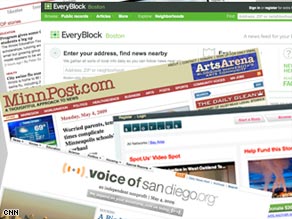Journalism can help bridge the digital divide by encouraging free distribution of content and tailoring web sites for different demographics. In doing so, journalism can ensure the differential use of the Internet is lessened with regard to both the social and global aspects of the divide. To understand how journalism can bridge the digital divide through the afore mentioned processes, one must examine the current progress of both free journalistic content distribution and tailored news websites. As a result, these strategies will be illuminated as successful tools for bridging the digital divide.
In order to better understand journalism’s influence on bridging the digital divide, one should look at both the social and global aspects of the theory. Rice (2002) breaks the definition down to these two aspects, showing the social divide relating to gender, race, income and geographic differences to access and use of the Internet. Moreover, he defines the global divide as the differential access to the Internet between countries as a result of lack of infrastructure (Rice, 2002). In light of this definition with regard to journalism, social divides such as income can be overcome by the free distribution of content. For example, the increase in newspaper and magazine readers shifting from print versions to their free online counterparts demonstrates the attractiveness of free journalism (Moses, 2011). In doing so, free journalism overcomes the income barrier by allowing different income level readers to view content without being discriminated against. Moreover, Jackson (2009) builds on this notion of free distribution by stating it is a person’s democratic right to have access to free news. She says “market failures emerge when news is conceptualized as just another commodity bought and sold in a capitalist economy, and there is a negative impact on democracy” (Jackson, 2009, p. 147). If all journalistic content were available for free online, the digital divide, with regard to social divides such as income barriers, would lessen. Furthermore, it would stimulate a demand for news which could lead to increase in profits for news organisations from advertising.

Not only can free distribution of journalistic content overcome social divides, it can overcome global divides as well. With regard to economics, Jackson’s (2009) notion of ensuring all news becomes a public good would correlate to an increase in the demand for news. As a result, one could argue that those with access to the Internet in countries defined as being ‘information poor’ would increasingly seek out free online news. Subsequently, this demand increase from information poor countries would spark an effect whereby citizens would place pressure on governing bodies to provide better infrastructure. Thus, the pressure would result in better infrastructure and a decrease in the differential access to the Internet.
In addition to free online journalistic content decreasing the digital divide, the notion of better tailored content to different demographics also applies. A prime example is Twitter, which has bridged the social divide with regard to race. While it is important to note Twitter is not strictly a journalistic web site, the microblogging site is one which is increasingly being used for journalistic purposes (Farhi, 2009). With this in mind, Wayne (n.d.) notes Twitter’s ability to decrease the digital divide by stating that “[a] quarter of (Twitter) users are African-Americans, the study found, about double their percentage of the American population” (Wayne, p. 1). Moreover, Yolanda (n.d.) looks more closely at African American’s use of Twitter and finds that most engage in tweeting their own opinion on journalistic content. As a result, Twitter’s use for journalistic purposes has helped bridge the social divide by increasing African Americans’ use of the Internet. Hence, such tailored news websites should follow in Twitter’s footsteps to continue bridging the digital divide.
Vromen (2007) identifies the youth-oriented media website VibeWire Youth Service as a site which attempts to bridge the differential use of the internet according to location. The site allows users to post their own articles with regard to opinions on politics with an emphasis on encouraging new users to become engaged in politics. As a result of the site’s tailoring tactics, it brought about a 19 per cent increase in the number of users from non-metropolitan areas (Vromen, 2007). Retrospectively, one can see how interactive journalism websites catered to specific markets can bridge the digital divide gap with regard to location. Journalism can thus continue to lessen the social gap by ensuring news websites cater toward a market which may be disadvantaged due to their geographic location.
Journalism is an ever-evolving profession which has helped bridge the digital divide since it first appeared on the Internet. The distribution of free content has ensured users have had no advantage over one another, as have the different news websites tailored to different audiences. However, the digital divide remains a pertinent issue in 21st century societies and will continue to be until people from all backgrounds have Internet access through convergent and mobile devices. Until then, journalism must continue to play its role in helping bridge the digital divide.
References
Rice, R. (2002), Primary Issues in Internet Use: Access, Civic and Community Involvement, and Social Interaction and Expression, London: In L. Lievrouw & S. Livingstone (Eds.), pp. 105–129
Farhi, P. (2009). The Twitter Explosion. American Journalism Review, 31(3), 26-31.
Jackson, P. T. (2009). News as a Contested Commodity: A Clash of Capitalist and Journalistic Imperatives. Journal of Mass Media Ethics, 24(2/3), 146-163.
Moses, L. MEDIA OUTLOOK (2011). Crossing the Digital Divide. MediaWeek, 20(34), 30-30.
Vromen, A. (2007). Australian young people's participatory practices and internet use. Information, Communication & Society, 10(1), 48-68.
Wayne, T. (n.d.) Awareness of Twitter Climbs Quickly. New York Times, 2.
Yolanda, Y. (n.d.) Black community is aflutter over Twitter, USA Today.















